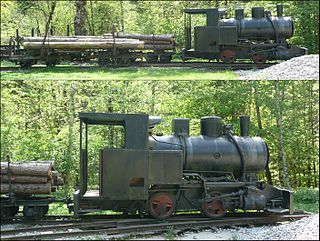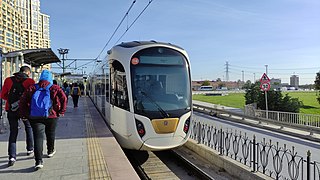

Reserved track, in tram transport terminology, is track on ground exclusively for trams.


Reserved track, in tram transport terminology, is track on ground exclusively for trams.

Unlike street running track embedded in streets and roads, reserved track does not need to take into account the transit of other wheeled vehicles, pedestrians, bicyclists or horses. It is the cheapest form of tram track to install (not counting land acquisition costs), and usually is constructed like railway track with conventional sleepers (railroad ties). [1]
Many modern tramway/light rail systems operate over reserved track formerly forming part of a heavy-rail network, e.g. Manchester, London and Nottingham (UK) and Sydney, Melbourne, and Adelaide in Australia.
Tram transport track can be either reserved track or street running type. [2]
An intermediate form, whereby tramlines are laid in the middle of a road, and segregated from other road users either by being raised approximately 10 centimetres above street level, and/or with small studs, or simply by a painted white line. This space is normally for trams only, or for trams, buses, taxis and emergency vehicles. However ordinary traffic may cross into the tram lane to pass parked vehicles. In Belgium this is known as a bijzondere overrijdbare bedding [3] or site spécial franchissable. The tram lane may be roughened by paving it with cobbles as an additional deterrent to use by rubber-tyred vehicles.[ citation needed ]

A tram is a type of urban rail transit consisting of rail vehicles, either individual railcars or self-propelled trains coupled into multiple units that run on tramway tracks on urban public streets; some include segments on segregated right-of-way. The tramlines or tram networks operated as public transport are called tramways or simply trams/streetcars. Trams are now commonly included in the wider term light rail, which also includes grade-separated segments of systems.

Light rail transit (LRT) is a form of passenger urban rail transit using rolling stock derived from tram technology while also having some features from heavy rapid transit.

A tram stop, tram station, streetcar stop, or light rail station is a place designated for a tram, streetcar, or light rail vehicle to stop so passengers can board or alight it. Generally, tram stops share most characteristics of bus stops, but because trams operate on rails, they often include railway platforms, especially if stepless entries are provided for accessibility. However, trams may also be used with bus stop type flags and with mid-street pavements as platforms, in street running mode.

The South Yorkshire Supertram, sometimes referred to as the Sheffield Supertram, is a tram and tram-train network covering Sheffield and Rotherham in South Yorkshire, England. The network is owned and operated by the South Yorkshire Mayoral Combined Authority (SYMCA).
There have been two separate generations of trams in London, from 1860 to 1952 and from 2000 to the present. There were no trams at all in London between 1952 and 2000.

The Blackpool Tramway runs from Blackpool to Fleetwood on The Fylde in Lancashire, England. The line dates back to 1885 and is one of the oldest electric tramways in the world. It is operated by Blackpool Transport Services (BTS) and runs for 18 km. It carried 4.9 million passengers in 2022/23.

Guided Light Transit was the name of guided bus technology and associated infrastructure designed and manufactured by Bombardier Transportation. It was installed in two French cities: Nancy and Caen. The Caen system was closed in 2017 and replaced by conventional trams, while the Nancy system was closed in March 2023 and is to be replaced by trolleybuses.

The Sydney tramway network served the inner suburbs of Sydney, Australia, from 1879 until 1961. In its heyday, it was the largest in Australia, the second largest in the Commonwealth of Nations, and one of the largest in the world. The network was heavily worked, with about 1,600 cars in service at any one time at its peak during the 1930s . Patronage peaked in 1945 at 405 million passenger journeys. Its maximum street trackage totalled 291 km in 1923.
Tramway track is used on tramways or light rail operations. As with standard rail tracks, tram tracks have two parallel steel rails, the distance between the heads of the rails being the track gauge. When there is no need for pedestrians or road vehicles to traverse the track, conventional flat-bottom rail is used. However, when such traffic exists, such as in urban streets, grooved rails are used.

Sheffield Tramway was an extensive tramway network serving the English city of Sheffield and its suburbs.

Doncaster Corporation Tramways was an electric tramway network serving the town of Doncaster, England. It was authorised in 1899, and the first route to Bentley opened in 1902. This remained separated from the rest of the system until North Bridge was built to carry traffic over the Great Northern Railway main line to Edinburgh. Soon afterwards, deep mining of coal began in the area, and several extensions to the system were made between 1913 and 1916 to serve new communities which developed around the pit heads. The Racecourse route was unusual, in that it had balloon loops at both ends to enable almost continuous running on race days, a feature that was not common in England, and only found favour in Europe in the 1950s and 1960s.

Tramways are lightly laid industrial railways, often not intended to be permanent. Originally, rolling stock could be pushed by humans, pulled by animals, cable-hauled by a stationary engine, or pulled by small, light locomotives. Tramways can exist in many forms; sometimes simply tracks temporarily placed on the ground to transport materials around a factory, mine or quarry. Many use narrow-gauge railway technology, but because tramway infrastructure is not intended to support the weight of vehicles used on railways of wider track gauge, the infrastructure can be built using less substantial materials, enabling considerable cost savings.

The Kingston upon Hull tramway network was a network of 4 ft 8+1⁄2 instandard gauge tram lines following the five main roads radially out of the city centre of Kingston upon Hull, East Riding of Yorkshire, England. Two of these lines went west, and two east. The fifth went to the north, and branched to include extra lines serving suburban areas. Additionally a short line linked the city centre to the Corporation Pier where a ferry crossed the Humber Estuary to New Holland, Lincolnshire.

A street running train is a train which runs on a track built on public streets. The rails are embedded in the roadway, and the train shares the street with other users, such as pedestrians, cars and cyclists, thus often being referred to as running in mixed traffic. Tram and light rail systems frequently run on streets, with light rail lines typically separated from other traffic.

The Frankfurt am Main tramway network is a network of tramways forming a major part of the public transport system in Frankfurt am Main, a city in the federal state of Hesse, Germany.

Between 1901 and 1949 Manchester Corporation Tramways was the municipal operator of electric tram services in Manchester, England. At its peak in 1928, the organisation carried 328 million passengers on 953 trams, via 46 routes, along 292 miles (470 km) of track.

The Istanbul nostalgic tramways are two heritage tramlines in the city of Istanbul, Turkey. The city has two completely separate heritage tram systems, one on the European side, the other on the Asian side.

The Istanbul Tram is a modern tram system on the European side of Istanbul. The first section, the T1 opened in 1992, followed by the T2, which opened in 2006. In 2011, the T1 and T2 merged, with the line retaining the T1 name. The T4, T5 and the T6 lines followed, opening in 2007, 2021 and 2024 respectively.

Dundee and District Tramways operated a tramway service in Dundee between 1877 and 1899.

Qingdao Tram is a tram system operating in Chengyang District, Qingdao, China. It was first launched in 2016. The Qingdao Public Transport Group Rail Bus Co., Ltd. is responsible for its operation and management.